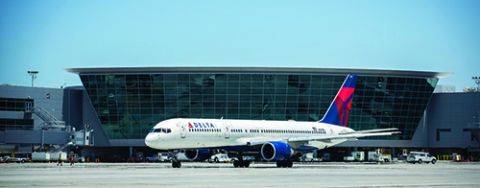San Diego Int’l Takes In-House Approach to Energy Management

At San Diego International Airport (SAN), energy planning and management runs in parallel with sustainability goals. As the airport has grown in recent years, officials identified the need for increased utility capacity and redundancy.
The project team at SAN used energy modeling to analyze the airport’s load profile during planning for the $811 million Green Build that was completed in 2013. The modeling illustrated how much power was currently being used, what would be necessary in the future, what was being supplied from the utility and the potential gap in between.
The solution was a 12kV electrical service and distribution system designed to reduce energy costs and provide resiliency and redundancy for the growing airport.
|
Project: Campus-Wide Electrical Service Location: San Diego Int’l Airport Owner: San Diego County Regional Airport Authority Cost: $28.7 million Project Scope: Design & install electrical utility grade 12kV power distribution system with utility grade controls & monitoring system; upgrade 12kV switchgears; eliminate numerous Authority-owned utility meters & migrate select facilities to 12kV loop Contractor: BSE Engineering Solar Elements: 5.5MW array built in 2016-17; 4MW hour, 2MW battery storage system currently in the works Annual Maintenance: $800,000-$1 million
Est. Energy Savings: Up to $100,000/yr |
“It’s not only planning for immediate needs, but long-term plans as well—coordinating with utility and stakeholders, and doing an analysis of what our requirements are now and what are they going to be and how can we meet them,” says Cogan Semler, energy manager with SAN’s Facilities Management Department.
The 12kV is comprised of five loops. One loop wraps around the perimeter of the airport campus; terminals 1 and 2 each have a loop; a fourth is located at the new parking plaza and the fifth is in the central utility plant.
Two primary circuits located in the airport’s main vault can each independently power the entire airport. Most days, however, each powers half. If the airport loses one of the primary power sources, the alternate circuit would come online, providing a high level of redundancy. Because the process is automated, power would be restored in a matter of seconds, notes Semler. The process can also be performed manually.
Throughout the five loops, automatic throw-over switch stations located where loads are connected allow the system to switch between the two primary circuits. If there is an issue at a specific load, it can be isolated so it does not impact the rest of the airport’s grid.
Additionally, the system includes a supervisory control and data acquisition (SCADA) system and sensors throughout the grid that measure voltage, current, which breakers are open and where there is/is not power. The SCADA system includes built-in logic that allows it to respond effectively and isolate trouble areas while maintaining power for the rest of the airport, Semler explains.
Along with separate vaults and special controls, the system is also programmed to load shed. For example, if the airport lost both primary circuits and the alternate circuit had less capacity available, the system is designed to take less critical loads off of the grid and maintain the critical loads instead of dropping the entire circuit.
 Critical systems, like sensitive explosives detection system machines that would be hampered by even momentary power interruptions, benefit from a closed transition. “Halting operations has a financial impact,” says Semler.
Critical systems, like sensitive explosives detection system machines that would be hampered by even momentary power interruptions, benefit from a closed transition. “Halting operations has a financial impact,” says Semler.
The 12kV loop system also allows SAN better control over its maintenance program, he adds. “Not having to rely so much on the utility when we have outages or projects going on where we need to tie in somewhere provides increased flexibility.”
Green Gains
“Sustainability is always one of our goals,” says Semler, noting that the 12kV system offers more opportunities to consolidate energy loads and provides more capacity for photovoltaics and other onsite renewable energy sources. It has resulted in reduced utility costs through demand savings from the local utility provider, consolidation of smaller meters and the integration of power, he reports.
The local utility provides three circuits (two primary plus an alternate), and SAN has a 5.5-megawatt photovoltaic solar array, installed in 2016-17. The airport is also in negotiations with a firm to install a 4-megawatt hour, 2-megawatt battery storage system that will allow the airport to further leverage solar power. Officials estimate the energy cost savings could approach $100,000 annually.
Given its small footprint of about 660 acres, SAN had to be creative about the installation of its existing solar array, and divided the infrastructure among three locations. Additionally, it has partnered with the local utility on a program that allows the airport to purchase renewable power from outside sources.
While solar is not a backup for SAN, it does supplement the airport’s power needs by about 15%. This, in turn, aids the Authority’s goal of reducing its environmental footprint.
2022 Charlotte Douglas International Airport Report of Achievement
 Giving back to the community is central to what Charlotte Douglas International Airport and its operator, the City of Charlotte Aviation Department, is about, and last year was no different.
Giving back to the community is central to what Charlotte Douglas International Airport and its operator, the City of Charlotte Aviation Department, is about, and last year was no different.
Throughout 2022, while recovering from the COVID-19 pandemic, we continued our efforts to have a positive impact on the Charlotte community. Of particular note, we spent the year sharing stories of how Connections Don't Just Happen at the Terminal - from creating homeownership and employment opportunities to supporting economic growth through small-business development and offering outreach programs to help residents understand the Airport better.
This whitepaper highlights the construction projects, initiatives, programs and events that validate Charlotte Douglas as a premier airport.
Download the whitepaper: 2022 Charlotte Douglas International Airport Report of Achievement.
 facts&figures
facts&figures








